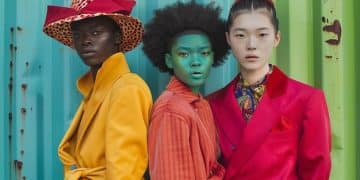Gen Z’s Influence on Pop Culture: 3 Viral Trends Shaping Today

Gen Z’s profound influence on pop culture is undeniable, as evidenced by their rapid adoption and propagation of viral trends that often reshape industries and redefine social norms within mere months, showcasing their unique digital fluency and cultural responsiveness.
In today’s fast-paced digital landscape, understanding Gen Z’s Influence on Pop Culture: 3 Viral Trends That Defined the Last 3 Months offers a crucial glimpse into the future of media, fashion, and social interaction. This generation, often characterized by its digital nativism and acute awareness of social issues, wields unprecedented power in shaping what captures collective attention and why.
understanding gen z and their cultural impact
Gen Z, broadly defined as individuals born between the mid-1990s and early 2010s, stands distinct from previous generations. They are the first true “digital natives,” having grown up entirely immersed in the internet, social media, and mobile technology. This intrinsic connection to digital platforms profoundly influences how they consume, create, and disseminate culture. Their networks are vast, immediate, and often global, allowing trends to emerge and spread with unparalleled speed, moving from niche communities to mainstream consciousness in a matter of days or weeks.
Their cultural impact is not merely superficial; it reflects deeper values and shifts. Gen Z often champions authenticity, diversity, and social justice. These values are not just buzzwords but are embedded in the content they consume and produce. Viral trends originating from this demographic frequently carry undertones of activism, inclusivity, or a rejection of established norms. This ability to infuse meaning into fleeting online phenomena makes their influence particularly potent. Furthermore, their preference for short-form, highly visual content means that trends are often expressed through memes, TikTok challenges, or aesthetic movements rather than traditional long-form media, demanding a different kind of engagement and understanding.
the genesis of gen z trends
Understanding how Gen Z trends begin is key to grasping their influence. Unlike traditional media, where trends were often dictated by editorial boards or record labels, Gen Z trends frequently bubble up from grassroots communities on platforms like TikTok, Instagram, and even niche subreddits. A seemingly innocuous video, a song snippet, or a unique fashion choice can suddenly gain traction, amplified by algorithms that prioritize engagement and novelty. This decentralized creation process means that anyone, regardless of background or celebrity status, has the potential to start the next big thing.
- Organic Emergence: Many trends start spontaneously, born from everyday creativity or genuine expression rather than calculated marketing.
- Algorithm Amplification: Social media algorithms play a crucial role, pushing content that resonates with early adopters to wider audiences, creating a self-reinforcing loop.
- Community Adoption: Once picked up by initial users, a trend gains momentum as more individuals recreate, remix, or react to the original concept, adapting it to their own contexts.
This dynamic interplay between individual creativity, algorithmic power, and community participation allows for rapid dissemination. It’s a testament to Gen Z’s collective power as cultural gatekeepers and innovators. They don’t just consume culture; they actively co-create it, often blurring the lines between creator and audience. Their cultural landscape is fluid, iterative, and constantly evolving, making it both challenging and fascinating to observe.
In essence, Gen Z’s impact on pop culture is not just about what becomes popular but how it becomes popular. Their digital fluency, combined with a strong sense of values, creates a unique ecosystem where trends are not just momentary fads but often reflections of deeper societal shifts and generational aspirations. This lays the groundwork for understanding the specific viral phenomena that have recently emerged from their sphere of influence.
trend 1: the rise of “de-influencing” and conscious consumption
One of the most significant viral trends that has defined the past few months, spearheaded largely by Gen Z, is the concept of “de-influencing.” This movement emerged as a direct counter-narrative to the pervasive consumerism often amplified by traditional influencer culture. Instead of promoting products and encouraging purchases, de-influencers meticulously scrutinize items that are overhyped, unnecessary, or simply not worth the investment. It’s a collective call for conscious consumption, urging followers to think critically before buying and to prioritize sustainability, utility, and authentic value over ephemeral trends and celebrity endorsements.
This trend gained significant traction on platforms like TikTok and YouTube, where creators would share honest reviews, often highlighting products that failed to live up to their promises or offering more affordable and effective alternatives. The appeal lies in its authenticity and the perceived transparency, directly contrasting with the polished, often sponsored content that has long dominated the influencer space. For Gen Z, who are highly skeptical of traditional advertising and acutely aware of environmental impact, de-influencing resonates deeply with their values of honesty and responsibility.
unpacking the “de-influence” phenomenon
The “de-influencing” trend is multifaceted, extending beyond just product reviews. It represents a broader shift in consumer behavior and a re-evaluation of what constitutes genuine influence. Gen Z is actively seeking out voices that align with their values, prioritizing relatability and integrity over aspirational lifestyles that seem unattainable or disingenuous. This has profound implications for brands and marketers, who are now forced to reckon with a generation that values transparency and substance far more than traditional marketing gimmicks.
- Authenticity Over Aspiration: De-influencing prioritizes real-world experiences and honest opinions, challenging the curated perfection often presented by traditional influencers.
- Skepticism Towards Hype: Gen Z is wary of overt marketing and collective hype, seeking independent verification and genuine utility before committing to a purchase.
- Financial Pragmatism: Amid economic uncertainties, this trend also reflects a practical approach to spending, encouraging wise choices and avoiding unnecessary expenditures.
This phenomenon also gives rise to a renewed appreciation for minimalism and thoughtful acquisition. Rather than acquiring for the sake of trends, younger consumers are being encouraged to invest in durable, versatile items, or to simply make do with what they already possess. This shift is not just about individual purchasing habits; it signals a growing cultural desire for less clutter, less waste, and more intentional living.

The “de-influencing” movement, therefore, is more than just a passing fad; it’s a powerful statement about Gen Z’s evolving relationship with consumerism. It champions a more mindful approach to buying, one that is rooted in personal values, financial prudence, and environmental consciousness. This has created a ripple effect, forcing brands to reconsider their marketing strategies and fostering a more critical and discerning consumer base. It highlights Gen Z’s power to not only create trends, but also dismantle them, shaping a new landscape of consumer culture.
trend 2: the resurgence of “core” aesthetics and niche communities
The past few months have witnessed an undeniable virality in “core” aesthetics, a phenomenon deeply embedded within Gen Z’s online culture. Unlike previous fashion or lifestyle trends that were often broadly defined, “core” aesthetics are hyper-specific, highly curated subcultures that fuse various elements—from specific eras and fictional worlds to unconventional interests—into unique visual and emotional identities. We’ve seen the rapid ascent of “Cottagecore” with its romanticized rural living, “Dark Academia” emphasizing intellectual pursuits and gothic architecture, and more recently, even “Clowncore” embracing playful, vibrant, and often whimsical clown-inspired elements.
These “cores” are not just about fashion; they encompass entire lifestyles, music choices, interior design preferences, and even personality traits. They are often born from niche online communities on platforms like TikTok, Tumblr, and Pinterest, where users collaboratively define and refine the aesthetics. This trend signifies Gen Z’s desire for intense self-expression and belonging within precisely defined communities, allowing individuals to explore identity in a highly creative and accessible way. It’s a rebellion against mainstream homogeneity, offering a myriad of pathways for personal identity.
the dynamics of niche aesthetic movements
The rapid proliferation of “core” aesthetics is fueled by several factors inherent to Gen Z’s digital behavior. First, the visual nature of platforms like TikTok and Instagram provides the perfect canvas for these aesthetics to bloom. Users create short videos, mood boards, and lookbooks that vividly illustrate their chosen “core,” which are then easily shareable and discoverable through hashtags and algorithmic suggestions. Second, there’s a strong communal aspect: individuals not only adopt these aesthetics but also contribute to their evolution, sharing resources, fashion tips, and art inspired by the specific “core.”
- Visual Storytelling: These aesthetics thrive on visual platforms, allowing users to convey complex moods and themes quickly and effectively through imagery.
- Community Building: “Core” aesthetics foster strong online communities where members feel a sense of belonging and shared identity, moving beyond simple consumption to active participation.
- Personal Identity Exploration: They offer a flexible framework for self-expression, allowing individuals to try on different personas and explore facets of their identity in a safe, creative space.
Furthermore, the iterative and adaptive nature of these trends means they rarely stay static. They often evolve, cross-pollinate, or give birth to even more specific sub-subcultures (e.g., “Gothic Academia” branching from “Dark Academia”). This constant creation and reinvention keep the overall trend fresh and engaging. It reflects a generation that values niche interests and the freedom to define oneself outside of traditional labels, prioritizing authenticity and personal resonance over broad appeal.
The rise of “core” aesthetics underscores Gen Z’s talent for building intricate, self-sustaining micro-cultures. These trends demonstrate a sophisticated understanding of visual language and community dynamics, enabling individuals to craft highly specific identities and find like-minded peers in an increasingly vast digital world. It’s a creative exploration of identity that continuously pushes the boundaries of what pop culture can encompass, signifying a shift towards more personalized and community-driven cultural movements.
trend 3: short-form video as the new storytelling medium – the memeification of life
Over the last three months, the absolute dominance of short-form video as the primary medium for storytelling, entertainment, and information dissemination on platforms like TikTok and Reels, has become undeniably viral among Gen Z. This isn’t just about quick dances anymore; it’s about the “memeification of life,” where every experience, emotion, or observation can be distilled into a concise, relatable, and often humorous video format. From explaining complex political concepts in 60 seconds to sharing deeply personal narratives through a series of rapid cuts and trending sounds, short-form video has become Gen Z’s preferred language, influencing everything from humor to news consumption.
This trend has shifted the landscape of content creation, emphasizing brevity, impact, and instant gratification. Creators are masters of condensing information, emotions, and narratives into incredibly brief packages that demand attention and encourage immediate engagement. The viral nature comes from the ease of replication, remixing, and sharing, allowing concepts, sounds, and visual styles to spread globally in a matter of hours. For Gen Z, who have grown up with a constant stream of information and instant access, this format perfectly aligns with their attention spans and desire for rapid consumption and creation.
the art of the viral short-form video
The success of short-form video lies in its ability to adapt and evolve rapidly, reflecting the real-time pulse of pop culture. What starts as a simple sound or a specific visual gag can quickly become a template for thousands, even millions, of unique interpretations. This is where the concept of “memeification” truly takes hold: an idea becomes a meme when it’s easily replicable, adaptable, and resonates broadly enough to be continually reinterpreted by different individuals. This constant iteration ensures the longevity and adaptability of trends, allowing them to remain relevant for longer than might be expected. The culture on these platforms is not just about passive viewing but active participation, encouraging users to respond, duet, or create their own versions.
- Information Density: Short-form videos excel at delivering condensed information or narrative arcs, maximizing impact in minimal time.
- Participatory Culture: The format encourages active participation through challenges, duets, and shared audio, turning viewers into creators.
- Emotional Resonance: Despite their brevity, many viral videos effectively convey a wide range of emotions, from humor to vulnerability, fostering deep connection.
Furthermore, these platforms have democratized content creation, making it accessible to anyone with a smartphone. This has led to an explosion of diverse voices and perspectives, enabling trends to originate from unexpected places and resonate with truly global audiences. The algorithm’s role in pushing relevant content to specific user groups also plays a pivotal part, curating individual feeds into tailored streams of highly engaging, often personalized, viral content. This constant flow of novel, bite-sized entertainment has effectively transformed how a significant portion of the population consumes and interacts with media.

The viral adoption of short-form video as a primary mode of expression and consumption signifies a fundamental shift in communication. It shows Gen Z’s preference for dynamic, engaging, and highly distilled content that requires active participation. This “memeification of life” defines how they share ideas, form connections, and collectively shape the ever-evolving narrative of contemporary pop culture. It is a powerful reminder that the new generation is not just consuming media, but actively defining its very nature, one viral video at a time, creating a constantly refreshing loop of content and connection.
| Key Trend | Brief Description |
|---|---|
| 🛒 De-influencing | Gen Z’s push for conscious consumption by discouraging overhyped product purchases. |
| 🎨 Core Aesthetics | Emergence of highly specific subcultures defining unique visual and lifestyle identities. |
| 🤳 Short-Form Video | Dominance of brief, impactful video content as the primary storytelling and entertainment medium. |
frequently asked questions about gen z trends
Gen Z’s approach to pop culture is deeply rooted in digital fluency, authenticity, and a strong sense of community. They prioritize engaging, interactive content and often contribute directly to cultural trends rather than passively consuming them. Their values, such as diversity and social justice, frequently influence the trends they champion.
“De-influencing” encourages more mindful and critical consumer behavior. It prompts consumers to question product hype, prioritize needs over wants, and seek out genuine utility. This trend pushes brands to be more transparent and align with ethical consumption practices to appeal to a discerning Gen Z audience.
“Core” aesthetics provide Gen Z with highly specific ways to explore identity and find niche communities. They offer tailored avenues for self-expression through curated visual styles, acting as a form of cultural rebellion against mainstream homogeneity and fostering a strong sense of belonging among like-minded individuals online.
Short-form video’s dominance stems from its brevity, high impact, and participatory nature, aligning with Gen Z’s preference for rapid consumption and instant engagement. It allows for quick dissemination of content, easy remixing, and fosters broad participation, transforming users into active creators and shaping the way information and entertainment are shared globally.
Brands should focus on authenticity, transparency, and genuine engagement. Instead of traditional advertising, they should aim to integrate organically with Gen Z’s values and platforms, potentially collaborating with creators who align with their ethos. Understanding and respecting the nuances of viral trends, rather than simply co-opting them, is crucial for meaningful connection.
conclusion
The past three months have vividly demonstrated Gen Z’s formidable influence on global pop culture, extending beyond mere digital fluency to redefine consumption, identity, and narrative. From the critical lens of “de-influencing” to the hyper-specific niches of “core” aesthetics and the pervasive impact of short-form video, this generation is not simply consuming culture; they are actively shaping its contours. Their collective power, amplified by social media algorithms and a shared demand for authenticity, means that understanding Gen Z is not just about tracking trends, but about recognizing fundamental shifts in how culture is created, exchanged, and valued. Future cultural landscapes will undoubtedly continue to bear the indelible mark of this dynamic and discerning generation.





